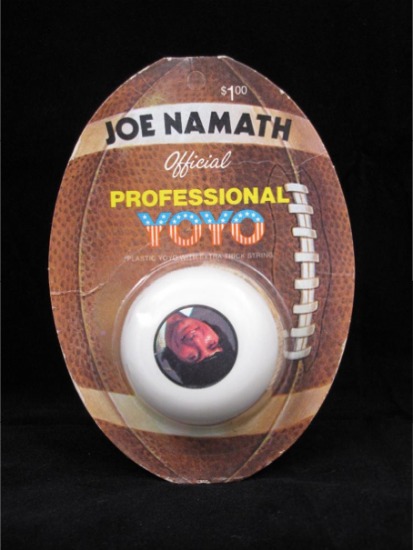The List: Smithsonian’s Top 11 Football Artifacts
The Smithsonian’s unique collection of football art, memorabilia and unusual artifacts
/https://tf-cmsv2-smithsonianmag-media.s3.amazonaws.com/filer/NFL-Super-Bowl-Smithsonian-artifacts-2.jpg)
The NFL’s lockout is over, the preseason is in full swing, and the regular season is set to kick off on September 8th. As we celebrate the return of football to America’s stadiums and airwaves, it seems timely to point out that one of the country’s greatest stores of football artifacts is held within the collections of the Smithsonian Institution. From relics of the sport’s dawn to modern-era tchotchkes, trace the evolution of the game via this unique collection.
Photos from early Princeton team: The early 1900s were an era in which football’s rules were still being debated and the game was just entering the national consciousness. This grainy set of photos shows Princeton’s team trying out the newly invented forward pass, among other innovations, in leather helmets and striped sweaters.
Red Grange etching: Grange was one of the game’s first superstars. At a time when the NFL lacked the credibility of college football, Grange’s 1925 signing with the Chicago Bears helped solidify the floundering league–and the crowds that gathered to watch him play may have well saved several franchises. This 1928 etching by Henry Farre shows “The Galloping Ghost” emerging from a scrum and running towards the end zone at Soldier Field.
William Zorach Sculpture: Zorach, a Lithuanian-born sculptor, was renowned for bringing European avant-garde concepts to American modernism. In 1931, he turned his eye towards the gridiron, creating this sleek lineman on one knee, now part of the American Art Museum’s collection.
Ivory Soap Giveaway: Back in 1935, before football had become the national obsession it is today, NFL tickets were freebies and given away with soap. This Proctor & Gamble newspaper ad details how fans can get a free admission to see the Philadelphia Eagles play the Brooklyn Dodgers (there was a football team too) with the purchase of four bars of soap. The copy reads, “Cheer on your team! Tire yourself out! Come home and dive into an exhilarating Ivory bath.”
Joe Namath Yo-Yo: Not many professional athletes make it on to a Yo-Yo. But there are few figures who deserve it more than Namath. Most famous for his prophetic guarantee that his Jets would upset the Colts in Super Bowl III, “Broadway Joe” was one of the NFL’s first crossover stars, hawking pantyhose in commercials, popularizing the glamorous sideline fur coat look, and starring in several films and TV shows.
Roger Staubach Jersey: In 1973, fresh off their first Super Bowl win, the Dallas Cowboys were just coming to national prominence and would soon be known as “America’s Team.” Because of the supposed Cowboys curse–many believed they were unable to win while wearing their navy blue jerseys–Staubach wore a white #12 jersey for most of the season, leading the team to a 10-4 record.
NFL Lunchbox: The 1970s were a time of lunchboxes, and the box of choice for any school-going football fan was surely this one. With the NFC teams’ helmets arranged in formation on the front and the AFC’s on the back, the tote is simply a testament to old school face masks and nonpartisan fandom. Go football!
Super Bowl XIV Ball: In the waning days of the Pittsburgh Steelers’ 70s dynasty, Terry Bradshaw took home his second consecutive Super Bowl MVP as his team defeated the Los Angeles Rams 31-19 with this ball. Held at Pasadena’s Rose Bowl, the game still holds the record for Super Bowl attendance, with 103,985 fans packed into the stadium.
Jerry Smith AIDS Awareness Trading Card: As recently mentioned on the Around the Mall blog, the American History Museum is home to a set of trading cards produced in the early 90s to raise awareness of AIDS. Smith, a standout Redskins tight end during the 60s and 70s, became the first former pro athlete to succumb to AIDS when he passed away in 1986.
Monday Night Football Stamp: In 1999, as part of its “Celebrate the Century” series, the USPS paid homage to Monday Night Football’s impact on American culture with this commemorative stamp. At 33 cents, it can’t mail a letter anymore, but it does make for a nice tribute to ABC’s innovative decision in establishing this football institution.
Brett Favre Portrait: In 2001, before his scandals and serial unretirements, Favre was simply a quarterback at the top of his game. After posing for this unusual Rick Chapman photo, he went on to set nearly every career passing record, play in 297 straight games, and become one of the sport’s most iconic players.
/https://tf-cmsv2-smithsonianmag-media.s3.amazonaws.com/accounts/headshot/joseph-stromberg-240.jpg)

/https://tf-cmsv2-smithsonianmag-media.s3.amazonaws.com/accounts/headshot/joseph-stromberg-240.jpg)